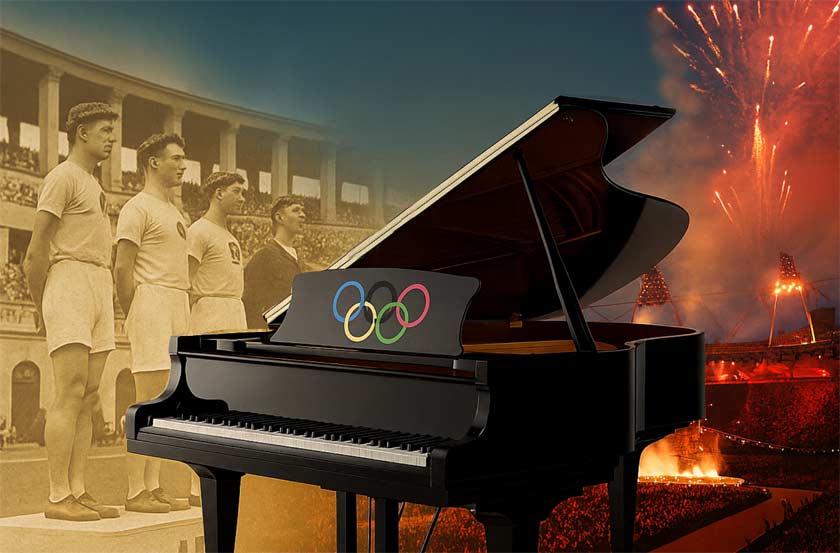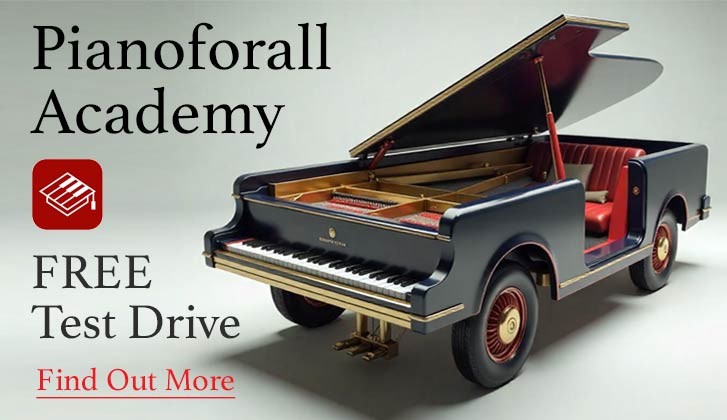When most people think of the Olympic Games, they picture sprinters on the track, gymnasts on the beam, or swimmers slicing through the water.
But there’s another, quieter Olympic tradition – one measured not in metres or seconds, but in notes and phrases.
For over a century, the piano has been part of the Olympic story, from the arts competitions of the early 20th century to the spectacular performances that light up modern opening and closing ceremonies.
The Forgotten Olympic Arts Competitions
Between 1912 and 1948, the Olympic Games hosted not only athletic contests but also arts competitions in five categories: architecture, literature, music, painting, and sculpture.
The idea, championed by the French aristocrat, and modern Olympics founder, Pierre de Coubertin, was to celebrate both physical and artistic excellence.
And just like in sport, winners in these competitions received gold, silver, and bronze medals.
In the music category, composers could submit original works inspired by sport — and some of those were written for, or prominently featured, the piano.
These compositions are largely forgotten today, but they remind us that, for a time, the Olympics crowned champions not just of the body, but of the creative spirit.
Piano Spectacles at the Opening Ceremonies
In more recent decades, the piano has moved from the competition floor to centre stage in the ceremonies that book-end the Games. Some of the most memorable moments include:
- Los Angeles 1984 – A jaw-dropping performance of Gershwin’s Rhapsody in Blue on 84 pianos simultaneously, creating a sweeping wall of sound that perfectly matched the Olympic scale.
- Beijing 2008 – A stunning duet between a 26-year-old Lang Lang and five-year-old prodigy Li Muzi, performing a newly composed eight-minute piano concerto by the Chinese composer Xiaogang Ye. The image of the two pianists — one at the height of global fame, the other just starting her musical journey — was a living symbol of passing the torch.
- Paris 2024 – French pianist Alexandre Kantorow opened with Ravel’s Jeux d’eau (Water Games), its shimmering textures perfectly fitting the aquatic theme. Later, Sofiane Pamart sat at a grand piano that was literally set ablaze as she performed John Lennon’s Imagine.
Pamart’s fiery performance also carried a thread of Olympic tradition — Imagine had been used in earlier opening ceremonies:
- London 2012 – The song was sung by a global children’s choir, each verse broadcast live from a different continent before merging into a unified chorus.
- Tokyo 2020 – In a Games delayed by the pandemic, Imagine was re-imagined as a multi-lingual, multi-artist collaboration, symbolising unity in isolation.
Piano Magic in the Closing Ceremonies
The closing ceremonies often give artists more room for play, and the piano has produced some unforgettable final notes:
- Paris 2024 – Swiss pianist Alain Roche performed on a suspended vertical piano, dangling above the stage as he played, the instrument tilted upright like a giant portrait frame of keys. It was half concert, half acrobatic act, and wholly mesmerising.
- London 2012 – Paul McCartney closed the Games at the piano, leading the stadium in a rousing Hey Jude, as the performance turned into one of the largest mass sing-alongs in Olympic history.
The Top 5 Most Unusual Olympic Piano Moments
- The Great Piano Army – Los Angeles 1984: 84 pianists pounding Gershwin’s Rhapsody in Blue in perfect sync.
- The Torch and the Child – Beijing 2008: Lang Lang and five-year-old Li Muzi sharing a stage for Xiaogang Ye’s brand-new concerto.
- Keys on Fire – Paris 2024: Sofiane Pamart playing Imagine while her piano was engulfed in flames.
- The Vertical Virtuoso – Paris 2024: Alain Roche performing high above the stage on a suspended upright piano.
- The Mass Choir Sing-Along – London 2012: Paul McCartney at the piano for Hey Jude, with tens of thousands singing along.
From Medals to Magic
Looking back, it’s fascinating to see how the piano’s place at the Olympics has shifted.
In the early 20th century, it was a competitive instrument, with works submitted to the arts competitions judged and awarded medals. From 1912 to 1948, a composer could stand on the Olympic podium just like a runner or gymnast.
Today, the piano is part of the Olympic spectacle rather than the medal count — a source of cultural pride and a vehicle for artistic storytelling in ceremonies watched by billions.
But the spirit is the same: to inspire, to unite, and to remind the world that the Olympics are not just about who can run the fastest or jump the highest, but about what humanity can create and share.
A Final Reflection
Sport and music might seem worlds apart, but both demand discipline, training, artistry, and heart.
Just as a sprinter works tirelessly to shave a fraction of a second off their time, a pianist labours over phrasing and touch until the performance feels effortless.
The Olympics is one of the few global stages where these two disciplines occasionally meet.
Whether it’s 84 pianos pounding Gershwin in Los Angeles, a child and a maestro sharing a keyboard in Beijing, or a grand piano set aflame in Paris, the message is the same: human achievement takes many forms.
And perhaps that’s the quiet magic of the piano at the Olympics. Amid the roar of the crowd and the clash of competition, a few notes can remind us why we gather in the first place — to witness the best of what we can do, and to celebrate it together.



